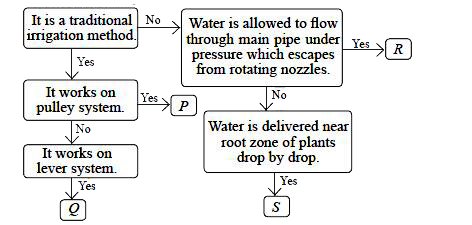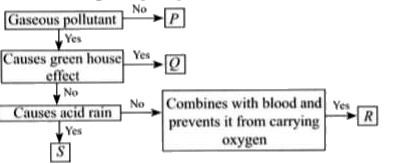Refer to the given dichotomous key and select the correct option regarding P, Q, R and S.
I. (a) Plant shows natural vegetative propagation. - Go to II
(b) Plant reproduces through asexual spores. - Go to III
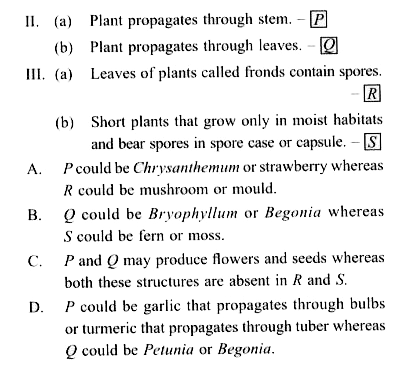
P could be Chrysanthemum or strawberry whereas R could be mushroom or mould.
Q could be Bryophyllum or Begonia whereas S could be fern or moss.
P and Q may produce flowers and seeds whereas both these structures are absent in R and S.
P could be garlic that propagates through bulbs or turmeric that propagates through tuber whereas Q could be Petunia or Begonia.
The correct Answer is:C
P shows natural vegetative propagation through stem, so P could be Chrysanthemum or strawberry. Q shows natural vegetative propagation through leaves. So, Q could be Bryophyllum or Begonia. R is a plant that reproduces through asexual spores and leaves of these plants are called fronds which contain spores. Hence R could be fern. Plant S reproduces through asexual spores and is short. It grows only in moist habitats and bear spare case or capsule. So, S could be moss.
Topper's Solved these Questions
Similar Questions
Knowledge Check
Refer to the given flow chart and select the correct option regarding P, Q, R and S.
 ADisease P is caused due to malfunctioning of exocrine glands while diseases Q, R and S are caused by pathogenic microbes.BS is a communicable disease while Q and R are non communicable diseases.CQ could be hepatitis B while R could be kala azar.DS could be sleeping sickness while R could be cholera.
ADisease P is caused due to malfunctioning of exocrine glands while diseases Q, R and S are caused by pathogenic microbes.BS is a communicable disease while Q and R are non communicable diseases.CQ could be hepatitis B while R could be kala azar.DS could be sleeping sickness while R could be cholera.Refer to the given Venn diagram and select the correct option regarding P and Q.
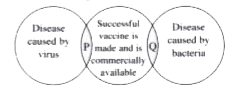 AP could be small pox whereas Q could be diphtheria.BP could be AIDS whereas Q could be malaria.CP could be common cold whereas Q could be whooping cough.DP could be typhoid whereas Q could be plague.
AP could be small pox whereas Q could be diphtheria.BP could be AIDS whereas Q could be malaria.CP could be common cold whereas Q could be whooping cough.DP could be typhoid whereas Q could be plague.Refer to the given diagram and select the correct option for the joints P, Q, R and S.
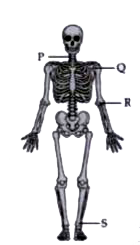 AJoint P allows movement in all directions.BJoint Q is also present in ankle.CJoint R is also present in knees.DJoint S allows only left and right movement.
AJoint P allows movement in all directions.BJoint Q is also present in ankle.CJoint R is also present in knees.DJoint S allows only left and right movement.
Refer to the given diagram of an animal cell and select the correct option regarding P and Q.
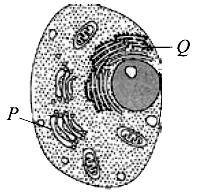
View Solution
Refer to the given figure and select the correct option representing the osmolarity at P,Q,R and S.
View SolutionRefer to the given diagram of an animal cell and select the correct option regarding P and Q
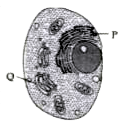
View SolutionRefer to the given Venn diagram and select the correct statement regarding P, Q and R.
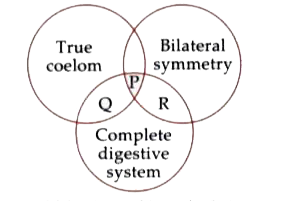
View SolutionRefer to the given dichotomous key and select the correct option regarding P, Q, R, S and T.
I. (a) Genetic material is not enclosed in nucleus. - Go to II
(b) Genetic material is enclosed in nucleus. - Go to III
II. (a) Lacks cell wall. - P
(b) Possesses cell wall. - Q
III. (a) Unicellular organism - R
(b) Multicellular organism - Go to IV
IV. (a) Plant body is sporophytic and water is required for fertilisation. - S
(b) Plant body is sporophytic and water is not required for fertilisation. - T
View Solution

